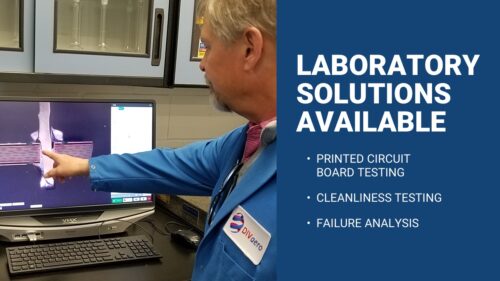DIVaero has engineers and technicians with years of experience in the PCB design, fabrication, validation and assembly sectors. This is what makes DIVaero a trusted PCB/PCBA laboratory solutions resource. We pride ourselves in developing unique laboratory solutions that meet your specific requirements and needs.
Our laboratory testing and validation service offerings allow us to determine if the printed circuit board is functional, reliable, and dependable. Therefore, rest assured that our services will give you the desired answers.
Laboratory Solutions Available
We provide our clients with world-class, advanced laboratory solutions for PCBs and PCB Assemblies, including BGA/LGA Removal and Replacement
Printed Circuit Boards – Approval for Use Validation
We offer an approval-for-use validation on printed circuit boards before they are assembled. Approval for use is laboratory verification to IPC-6012 for Qualification and Performance Specification for PCBs and IPC-A-600 Acceptability of PCBs, including Bare Board Electrical Test.
We recommend “approval for use” before assembling a printed circuit board. Once assembled, it is extremely difficult to determine if issues are the result of the bare board fabrication process or the assembly process.
Board level evaluation may include (but is not limited to) :
- Thermal Stress and Solderability
- Hot Oil Delamination for multi-layer boards
- Micro Sectional analysis
- Cleanliness testing
- XRF for the thickness of the surface finish (Gold, Nickel, Silver, Tin, HASL)
- DSC laminate evaluation to verify the Tg (glass transition temperature)
- Bare Board (electrical) testing to the IPC-D-356 Net List
Cleanliness Testing
Board-level evaluation may include cleanliness testing, which refers to examining a specimen or foreign residue to determine the type or amount of contaminant present.
Two types of cleanliness testing methods are offered:
- Modified ROSE Testing: ROSE (Resistivity of Solvent Extract), which is a test that determines the average concentration of soluble ionic contaminants. It involves flushing the surface with a 2-propanol/water mixture. It is in effect a GO/NO-GO test for contamination.
- Ion Chromatography Testing: This test can verify PCB cleanliness, determining the specific ionic contamination present. Where the Mod ROSE testing is GO/NO-GO, Ion Chromatography gives the customer knowledge of the specific ions contaminating their product.
 Failure Analysis of PCB Assemblies
Failure Analysis of PCB Assemblies
Assembly Failure Analysis is based on a combination of X-RAYs followed by cross-sectional analysis. Microsection is performed on the part and the solder connection to best view the metallurgical attachment and/or failure using successive grinds with measurements and pictures at each grind depth. Then components are stressed and fractured to observe the failure mechanism. This tells if the solder joint is stronger than the attachment of the copper land to the PCB. Once the solder connection is stronger than the PCB pad adhesion, the joint is strong enough. If needed or requested by the customer, thermal shock may be used, which (again) is analyzed by microsection after the shock.
- REFLOW ANALYSIS
Reflow analysis is based on the metallurgical bond that was achieved and the flow of the solder paste. For a BGA, the ball collapse and the attachment of the ball to the interposer board and the PCB are analyzed with a microsection and 3D X-Ray that performs a 360-degree CT scan. Ultimately, the extent of the intermetallic formation is viewed from the microsection.
- ASSEMBLY ANALYSIS
J-STD-001Requirements for Soldered Electrical and Electronic Assemblies and IPC A-610 Acceptability of Electronic Assemblies are the guidelines for assembly analysis. A “fracture” of select components is performed to determine the failure mechanism. We have developed standards for fracture force (these are not recognized by the IPC, but we have found them to be very predictive of performance). The failure analysis methodology used by DIVaero helps us determine which protocols to enlist for the respective failures of the assembly.
Outstanding Laboratory Solutions for Your PCBs and Assemblies
We provide a long list of testing and validation services for your PCB to ensure they’re high quality and suitable for use. These services are essential for your products’ success and meeting all industry standards.
Our state-of-the-art laboratory solutions are backed by a team of highly qualified professionals committed to providing you with the best outcome regarding your PCBs. So if you’re looking for reliable, fast, and dependable laboratory services for your PCB or PCBA, contact us today or request a quote.

 Failure Analysis of PCB Assemblies
Failure Analysis of PCB Assemblies